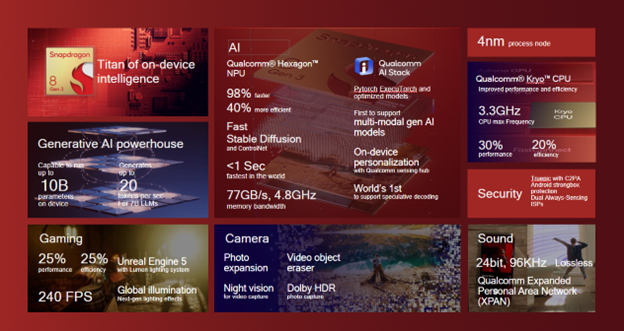Mobile phone enthusiasts will be thrilled to learn that Qualcomm has announced yet another chipset to its iconic Snapdragon range with the Snapdragon 8 Gen 3. But can it compare to Google’s latest offering?
The mobile phone industry has seen a massive boon this year, with the launch of plenty new smartphones from the likes of Google, Apple, Motorola and many others. It’s not all about the hardware, however, as Qualcomm has managed to steal the limelight with the announcement of the Snapdragon 8 Gen 3.
Today, we’re going to be running through all the key differences and similarities between the latest Snapdragon 8 Gen 3 and Google Tensor G3, which launched earlier this year alongside the Google Pixel 8 series. Keep reading to find out more about these two chipsets.
Google Tensor G3 is exclusive to Google handsets
Google launched its latest chip with the Pixel 8 and Pixel 8 Pro range of handsets. The first Google Tensor chip was introduced with the Pixel 6 and Pixel 6 Pro in 2021 and was the first time the company started developing and implementing its own chipsets. Due to this, the Tensor G3 can only be found in Google hardware, meaning that you won’t be able to find it in third-party handsets.
Qualcomm, on the other hand, develops chips to be used in third-party handsets, meaning that you’re more likely to come across it when shopping from various brands. The last-generation Qualcomm chip, the Snapdragon 8 Gen 2, is featured in a wide variety of devices, including the OnePlus Open, OnePlus 11, Xiaomi 13 Pro, and Samsung Galaxy Z Flip 5 and Galaxy Z Fold 5, although the latter include a specially developed chip, Snapdragon 8 Gen 2 for Galaxy.
Both chips have camera AI trickery
One of the biggest takeaways we took from our time with the Pixel 8 is the various AI tricks that are used across the camera app. One of the best features is Magic Eraser, which allows you to remove photobombers or objects from the background of pictures. Best Take also generates an image with everyone’s best smiles in an image, ensuring that you get the best shot every time you take a group picture.
Qualcomm has also worked hard in this area, going so far as to claim that the Snapdragon 8 Gen 3 will deliver the “world’s smartest AI-powered camera”. Video Object Eraser will work in a similar way to Magic Eraser, removing unwanted people and objects from video captures.
Zoom Anyplace, which is powered by Samsung’s first 200-megapixel image sensor for Snapdragon, allows for the capture of multiple videos, object tracking and 2x and 4x optical zoom, all in 4K. First HDR photo technology from Dolby will also enable capture and playback from images with a greater range of colours, tones and shades to make imagery more immersive and realistic.

Both are built on a 4nm process node
Google has been fairly tightlipped about the specifics of the Google Tensor G3, but reports suggest that it’s built on a 4nm process, a big improvement over the 5nm process node on the Google Tensor G2. It’s also said to feature 9 cores and a maximum clock speed of 2614Hz. Our review of the Pixel 8 noted that the handset was generally very responsive, with smooth execution when scrolling through media-intensive apps.
Qualcomm took a leaf out of Google’s handbook, building the Snapdragon 8 Gen 3 on a 4nm process node. The Kyro CPU touts a maximum frequency of 3.3GHz and packs a 30% performance boost compared to its predecessor, alongside a 20% boost in power efficiency.

Snapdragon 8 Gen 3 is better equipped for gaming
Google didn’t put a lot of emphasis on the gaming prowess of the Google Tensor G3. It does now come with ray tracing capabilities, but we found that a short 15-minute session of Survivor.io – a cartoon-y 2D top-down shooter – brought on a few frame rate drops and a bit of stuttering. For a game that generally runs well on mid-range chipsets, this was a disappointing performance and proves that the Tensor G3 isn’t the best pick for avid mobile gamers.
Qualcomm claims that the Snapdragon 8 Gen 3 comes with Hardware-Accelerated Ray Tracing with Global Illumination, brought about by support for Unreal Engine 5.2. The company claims that this chip is capable of playing games at up to 240fps on 240Hz displays and can upscale gaming scenes up to 8K on external displays with Snapdragon Game Super Resolution.
The Adreno GPU also provides a 25% performance boost alongside 25% better power efficiency and a 40% increase for ray tracing. This should make the Snapdragon 8 Gen 3 a lot more alluring for mobile gamers, although the performance will be impacted by the handset it’s used with.











